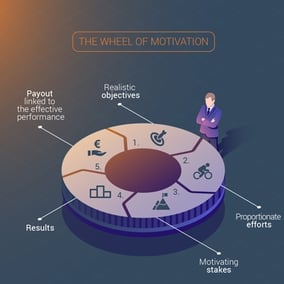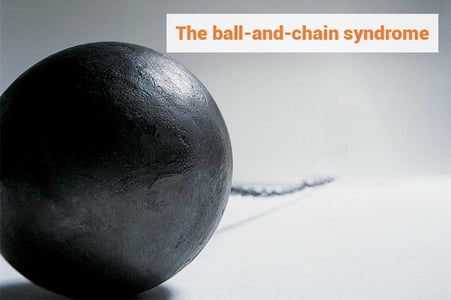Incentive compensation aims to foster motivation, but it is not the only tool that can increase performance. The role of managers is essential, as are marketing tools and other elements. Moreover, a poorly-conceived incentive strategy can actually have negative effects on motivation levels.
Motivation circle
In order to understand the impact of incentive compensation on motivation, we must examine the full range of stages in an employee’s motivational journey.
- Realistic objectives in order to avoid demotivation from the get-go
- Proportionate effort: carefully adjusting the effort/reward balance
- A balanced set of objectives to allow for variable and reversible compensation
- Results that meet a clearly-defined objective
- Value levels in accordance with the beneficiary’s expectations
When drawing up our variable compensation plans, the company issues a performance requirement to which a compensation scheme is attached.
The employee’s first instinct will be to assess the feasibility of the challenge they’ve been set, and whether it seems fair. There’s no point in asking a casual jogger to take the starting line at a marathon.
An employee will measure the efforts they need to produce in order to meet their objectives in terms of risk/reward. If the potential outcome is sufficiently attractive, they will want to get in the race, and above all will be incentivised to sustain their effort levels in order to obtain the best possible result.
In addition, the employee will be highly attentive to the intermediary and final results they achieve, in order to systematically verify their accuracy.
Finally, during last step in the motivation cycle, they will verify that the value of the compensation acquired in return for the performance delivered meets with expectations.
Throughout each one of these steps, any dysfunction in the system or a simple technical mistake can cause employees to fall out of sync with the motivation cycle. They may even produce the opposite effect to those initially sought, which is why it is so important to apply a meticulous approach when building bonus schemes.
Two conditions for effectiveness: variability and reversibility
The motivational nature of incentive compensation resides less in the level of challenge issued to the staff member (i.e. the bonus being sought for a given objective), and more in a combination of two conditions: the risk of losing and the perspective of earning a lot.
As a result, incentive levels can revert to 0 if the employee’s performance is far below the level expected. At the same time, a maximum bonus must also be attainable for a performance that significantly surpasses expectations.
Incentive is therefore variable based on performance, but also reversible - which means that, at the beginning of each performance cycles, all employees are once again in a position to achieve their bonus. The feeling among some team members that their bonus is guaranteed, or among others that they are locked out of the bonus scheme, are both pitfalls which can cause the company to miss out on achieving the best possible collective performance.
In order to enable variation and reversibility, the rate of incentive compensation must not be excessive. In practice, it has been observed that beyond an average rate of 30 - 40% of global package, the proportion of variable income becomes impossible to vary (on both a managerial and social level). Conversely, the objective set must be sufficiently significant to ensure that the employee is motivated by this component of their global pay. The level below which behaviour tends to be more opportunistic than voluntarist is around 8 - 10%, roughly equivalent to a month of fixed salary.

 Definition of incentive compensation
Definition of incentive compensation This is the oldest but also the best known and commonest tool. It involves paying the employee a percentage of the profit (s)he generates.
This is the oldest but also the best known and commonest tool. It involves paying the employee a percentage of the profit (s)he generates. 















